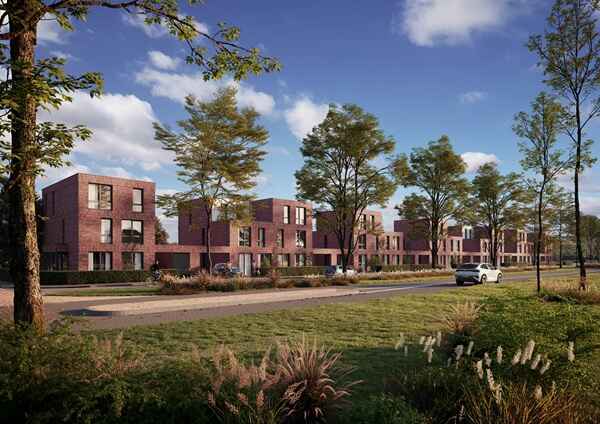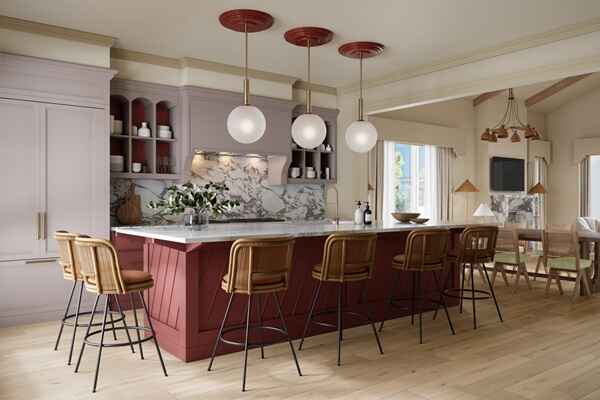Thinking about investing in 3D rendering services? You’re not alone. Many businesses like construction companies, interior designers, and architectural firms are leveraging these 3D services to enhance project visualization, streamline decision-making, and ultimately boost their ROI. This article will dive into the critical reasons why 3D rendering is worth the investment.
3D Rendering as a Business Decision, Not Just an Aesthetic One
Gone are the days when 3D rendering projects was seen merely as an artistic endeavor. Today, it is a critical business powerful tool in the architecture and real estate sectors. The ability to create realistic visualizations of future projects and architectural spaces has become an industry standard, enhancing project marketability and facilitating quicker sales and higher prices. Additionally, the use of a 3D render can significantly improve the presentation of these ideas and support development process.
#1 3D Architectural Rendering: A Cost or a Profitable Investment?
Investing in 3D rendering services is a strategic business decision that can lead to measurable returns. High-quality 3D renders can identify design issues early in the process, leading to substantial time and cost savings. The complexity of a project significantly influences the costs associated with 3D rendering services, but the investment is worth it.
Architectural visualization services, including bird’s eye views, interior spaces rendering and exterior renderings, are investments that can pay off handsomely. Ordering 3D services at an architectural rendering studio helps elevate the market appeal of properties, making them more attractive to potential buyers and enabling higher pricing strategies.
#2 Why Is “Showing” More Effective Than “Telling” Plans?
In the modern architecture sales landscape, visual content often surpasses verbal descriptions in effectiveness. Architectural 3D rendering services provide a powerful way to convey design elements like furniture placement, room layout, lighting and texture, as if they were physically present, which traditional blueprints cannot achieve. This visual approach enhances client understanding and satisfaction, making it easier for them to envision the final architecture and make informed decisions.
Visual presentations are more persuasive in sales as they allow potential buyers to experience a property before it is constructed. This 3D experience, created through 3D renders and virtual reality, provides a more compelling and impactful way to showcase project information about future buildings. Creating 3D visualizations of projects significantly improve clients’ decisions and overall satisfaction.

3D exterior rendering of living at Croonhoven, Netherlands, crafted by RNDR
Does Investing in 3D Rendering Pay Off? Understanding ROI
The return on investment (ROI) for 3D rendering services can be substantial. Enhanced customer engagement and satisfaction through 3D architectural visualizations can lead to better returns via faster project approvals and quicker sales cycles. The ability to present high-end 3D visualizations of architectural designs and product showcases allows clients to make decisions more rapidly and confidently.
Investing in architectural 3D rendering services can significantly boost your favorable result. These services not only improve visual communication but also streamline the decisions, ultimately leading to enhanced client satisfaction and faster project approvals.
Understanding the ROI of these services is crucial for a professional rendering firm looking to stay competitive in the market.
#1 Faster Client Decisions Through Realistic Architectural Visualization Services
High-quality, lifelike visualizations created by rendering studios help potential customers make project decisions more quickly and confidently. 3D renders can reduce the time of design development by allowing users to make decisions by providing a clearer understanding of the final architecture. 3D visualization services, virtual reality, flythrough animations and other rendering services create immersive experiences, facilitating quicker client evaluations and faster decision-making.
3D services include visuals and dynamic visual representations that allows clients to visualize the final result as in real life. This clarity and confidence are crucial for faster decision making process, ultimately leading to more efficient rendering projects timelines and higher client satisfaction.
#2 Lower Costs by Avoiding Design and Implementation Errors
Renderings make it possible to identify and correct mistakes early, before production or construction begins, saving both time and money. By visualizing designs in 3D, potential design flaws can be addressed before any physical work begins by project managers and art directors, minimizing costly adjustments later. This proactive approach ensures that exterior and interior designs are accurate and aligned with client expectations throughout the construction process.
Utilizing 3D renderings allows for the early identification of potential design flaws, reducing costly adjustments during later stages. This not only save time but also ensures that the design process is more efficient and cost-effective. Visualizing design concepts in a realistic setting helps avoid expensive rework, ensuring the final architecture meets all specifications through 3D visualization and 3D floor plan renderings.
#3 How Professional Architectural Rendering Studio Increases Product and Property Value
Premium 3D visuals enhance the perceived quality and desirability of products and real estate, allowing companies to justify higher prices. High-quality 3D renderings can elevate the market appeal of properties, making them more attractive to potential buyers. This increased attractiveness supports higher pricing strategies and enhances the overall value of the final architecture .
Real estate developers and architectural firms can significantly benefit from investing in photorealistic rendering services. Creating lifelike 3D visualizations of both interior and exterior spaces enhances the perceived value of projects. This not only boosts marketability but also ensures that properties stand out in a competitive market.
Can 3D Visualization Be Considered a Form of Business Insurance?
Using 3D rendering can mitigate financial risks by:
- Ensuring that project details are accurately represented before construction begins.
- Acting as a form of business insurance, safeguarding against costly mistakes.
- Ensuring that the final delivery aligns with the client’s vision.
- Providing a clear and precise visualization of the project through 3D rendering services.
- Reducing the likelihood of misunderstandings and financial losses.
Utilizing 3D rendering can safeguard businesses against financial losses by ensuring design clarity and reducing costly mistakes. Offering photorealistic renderings ensures all stakeholders have a clear project understanding from the outset. This approach minimizes risks and enhances the overall success of the project.
#1 A Clear Vision and Architectural Project Presentation for All Parties (Preventing Client–Contractor Conflicts)
Accurate visualizations prevent misunderstandings between clients, designers, and contractors by aligning everyone’s expectations from the start. Visual representations created through 3D rendering facilitate clear communication among stakeholders, reducing the chance of conflicts. This clarity ensures that the entire project is executed smoothly and efficiently, enhancing the project’s success.
Effective 3D renderings foster better collaboration by providing all stakeholders with a tangible view of the project, reducing potential disputes. Offering detailed and accurate architectural renderings ensures all parties are aligned. This alignment is crucial for preventing client-contractor conflicts and ensuring the successful completion of the project.
#2 Safe Verification of Colors, Materials, and Design
Rendering provides a risk-free way to test and approve details before any real-world investment. 3D rendering allows for the evaluation of design elements like colors and textures in a simulated environment, which minimizes costly mistakes. This approach ensures that interior design and exterior designs are accurate and aligned with client expectations.
3D rendering allows clients to explore and finalize material choices and colors in a controlled setting, mitigating risks before actual implementation. Photorealistic renderings ensure all design concepts are thoroughly tested and approved before construction. This not only minimizes risks but also enhances client satisfaction and confidence of the final product.
#3 Building a Reputation for Quality Focused Company
Consistent use of professional 3D visuals strengthens a brand’s image as reliable, innovative, and quality-driven. Employing high-quality 3D renderings consistently enhances customer trust, positively influencing a company’s reputation and client retention. Delivering exceptional quality in architectural rendering services helps firms build a reputation for quality and reliability.
Companies that consistently deliver high-quality 3D visualizations are more likely to gain client trust and improve customer loyalty. By leveraging the expertise of a dedicated team and providing architectural rendering services that include realistic and photorealistic visualizations, a rendering company can ensure that their brand stands out in a competitive market. This reputation for quality can lead to increased business opportunities and long-term success.

Interior rendering of Fairway Home in Wild Skies style, Florida, USA, crafted by RNDR
Gaining a Competitive Edge with Architectural Rendering Services
Utilizing 3D rendering can significantly enhance the customer experience by:
- Providing detailed visuals that facilitate decision-making.
- Allowing companies to effectively differentiate themselves in the market, enhancing their appeal to potential clients.
- Creating lifelike 3D visualizations of exterior designs and interior renderings, which provides a market advantage and attracts more business opportunities.
The ability to create high-end visuals and photorealistic renderings allows firms to stand out in a crowded market. Utilizing architectural visualization services and standardized rendering processes ensures consistent quality and efficiency. This unique selling point (USP) is crucial for firms looking to enhance their market presence and attract potential clients.
#1 Standardized Rendering Processes: Animation, VR, and Virtual Tours
Modern formats such as animations and immersive virtual experiences create more engaging and memorable presentations. Employing animations and virtual tours can elevate the engagement level of presentations, making them more impactful. Standardized rendering methods improve production efficiency and ensure a consistent quality of visuals across various platforms.
Architectural animations, virtual tours, and photorealistic visualizations create immersive experiences that captivate potential clients. These dynamic visual representations enhance the overall presentation of the architectural project and ensure that the project’s success is achieved through clear and compelling visual communication.
#2 Easy Updates to Marketing Materials
3D assets are flexible, offering several advantages:
- Allowing quick adjustments or reuse across campaigns, saving both time and resources.
- Enabling efficient updates, which optimize marketing efforts.
- Facilitating swift updates to marketing materials to reflect design changes or new information without significant rework.
Utilizing 3D rendering services ensures marketing materials are always up-to-date and aligned with the latest design concepts. This flexibility and efficiency in updating mood boards and other marketing collateral enhance the overall effectiveness of marketing campaigns. It ensures that potential clients always have access to the most accurate and compelling visual information.
#3 Standing Out from the Competition
High-end 3D visuals make a brand instantly recognizable and more appealing in a crowded market. Distinctive 3D visuals can effectively highlight a brand’s unique features, giving it an edge in a competitive marketplace. Utilizing high-quality 3D renderings can enhance customer trust and perception of value, leading to higher conversion rates.
Delivering exceptional quality and stunning visuals in architectural rendering services helps firms stand out from the competition. These visuals not only enhance the aesthetic appeal of the project but also ensure that all the details are accurately represented. This level of detail and quality can lead to exceptional results and a competitive advantage in the market.
Final Thoughts: Why 3D Architectural Visualization Is Worth the Investment
Investing in 3D rendering goes beyond a simple visual upgrade. It represents a strategic maneuver that drives faster decisions, reduces risks, and strengthens brand positioning. For forward-thinking companies, 3D rendering is not just an option – it’s an essential advantage. Offering compelling architectural renderings ensures projects stand out and meet high client expectations.
The ability to present stunning and realistic visualizations of architectural designs allows firms to differentiate themselves in a competitive market. By leveraging 3D rendering services, companies can enhance their marketability, attract more clients, and ultimately achieve greater success.
With the continuous advancements in technology and the increasing demand for high-quality visuals, investing in 3D rendering is a decision that pays off in the long run.
If you need professional 3D rendering company support for your next project to enhance your designs and boost client engagement, visit Render Art Studio.



